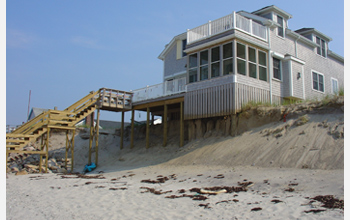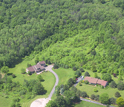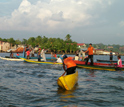News Release 08-173
NSF Awards 10 Grants for Studies of Coupled Natural and Human Systems
Future of coastal barrier islands; tree growth in changing agricultural areas; urban vulnerability to climate change among research projects

Fragile barrier beaches like this one in Massachusetts are sites of CNH research.
October 3, 2008
This material is available primarily for archival purposes. Telephone numbers or other contact information may be out of date; please see current contact information at media contacts.
To better understand the interactions between humans and their environment, the National Science Foundation (NSF) and the U.S. Forest Service have awarded 10 grants to scientists, engineers and educators across the country to study coupled natural and human systems.
Research conducted through NSF's Dynamics of Coupled Natural and Human Systems (CNH) Program, in its second year as a multi-directorate NSF program, will provide a better understanding of natural processes and cycles, human behavior and decisions and how they interact.
The CNH program is supported by NSF's directorates for biological sciences, geosciences and social, behavioral amd economic sciences.
This year's awards will address topics including the uncertain future of coastal barrier islands, urban areas and their vulnerability to climate change, tree growth and carbon cycling in agricultural areas changing to residential areas, and how best to integrate industrial ecology and ecological engineering.
"Several of these awards will investigate how climate change will impact human and natural systems, and how these coupled systems may respond adaptively," said James Collins, NSF assistant director for biological sciences. "The awards highlight the relevance and interdisciplinary nature of the CNH program in NSF's portfolio of investments in climate change research."
"The CNH program has been successful in building new bridges connecting several of NSF's directorates, including the geosciences directorate," said Timothy Killeen, NSF assistant director for geosciences. "Pioneering work in this program is leading to a better understanding of the relationship between humankind and the complex environmental and biological systems that support life. Such studies will become more important as awareness grows of the finite limitations of our planet's resources, and of the extent of human interactions and interventions with the earth system."
"Studying coupled human and natural environmental systems shows new, complex patterns that the natural and human sciences don't reveal when they function separately," said David Lightfoot, NSF assistant director for social, behavioral and economic sciences. "Research on environmental change, in terms of human causes and consequences, is a new kind of complexity science that has yielded interesting interactions."
This year's grantees will study:
- The drowning of developed coastal barrier islands, investigating the threshold rates of sea-level rise on the geologic-human system (Andrew Ashton, Woods Hole Oceanographic Institution)
- How best to integrate industrial ecology and ecological engineering (Bhavik Bakshi, Ohio State University)
- Spatial land-use change and ecological effects: how land management and carbon dynamics interact (Daniel Brown, University of Michigan at Ann Arbor)
- Urban vulnerability to climate change (Sharon Harlan, Arizona State University)
- Grassland dynamics in the Tibetan highlands: livestock, wildlife, and the culture and political economy of pastoralism (Richard Harris, University of Montana)
- Interactions of climate change, land management policies, and forest succession on fire hazards and ecosystems in the interface between wildlands and urban areas (Bart Johnson, University of Oregon at Eugene)
- Pueblo ecodynamics over long periods (Timothy Kohler, Washington State University)
- Globalization and the connection of remote communities, and its environmental implications (Daniel Kramer, Michigan State University)
- Developing an international network of research on coupled human and natural systems (Jianguo Liu, Michigan State University)
- Modeling of ecosystem services, incentive-based policies, land-use decisions, and ecological outcomes (Stephen Polasky, University of Minnesota)
-NSF-
-
CNH scientists will study tree regrowth in urban areas changing from agricultural to residential.
Credit and Larger Version -
Scientists awarded a CNH grant will investigate climate change impacts in cities like Phoenix.
Credit and Larger Version -
Market access may lead to the unsustainable harvest of shrimp off Nicaragua, say CNH scientists.
Credit and Larger Version
Media Contacts
Cheryl Dybas, NSF, (703) 292-7734, email: cdybas@nsf.gov
The U.S. National Science Foundation propels the nation forward by advancing fundamental research in all fields of science and engineering. NSF supports research and people by providing facilities, instruments and funding to support their ingenuity and sustain the U.S. as a global leader in research and innovation. With a fiscal year 2023 budget of $9.5 billion, NSF funds reach all 50 states through grants to nearly 2,000 colleges, universities and institutions. Each year, NSF receives more than 40,000 competitive proposals and makes about 11,000 new awards. Those awards include support for cooperative research with industry, Arctic and Antarctic research and operations, and U.S. participation in international scientific efforts.
Connect with us online
NSF website: nsf.gov
NSF News: nsf.gov/news
For News Media: nsf.gov/news/newsroom
Statistics: nsf.gov/statistics/
Awards database: nsf.gov/awardsearch/
Follow us on social
Twitter: twitter.com/NSF
Facebook: facebook.com/US.NSF
Instagram: instagram.com/nsfgov





